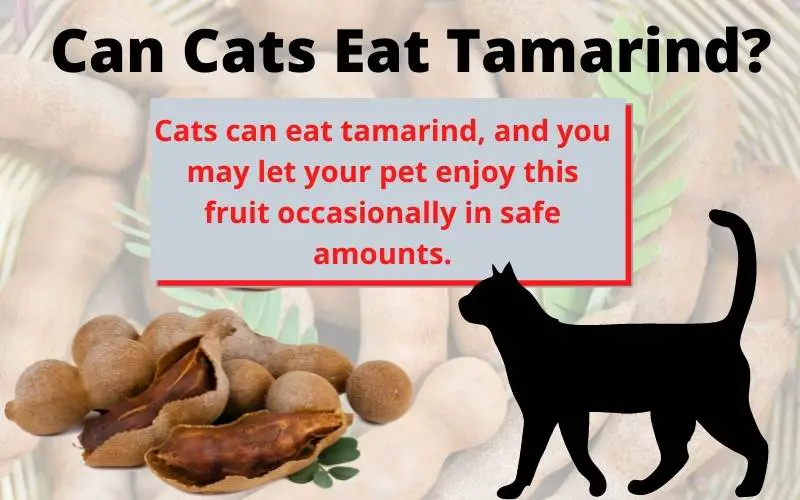Cat owners have to be careful as to what their pet is eating. Some fruits and vegetables can be toxic for your feline, resulting in severe health complications. Can Cats Eat Tamarind?
Is tamarind one of them? Well, not really! There is not much evidence to indicate that tamarind is not safe for cats. It has a sweet and sour taste that may appeal to cats along with humans.

Can Cats Eat Tamarind?
Cats can eat tamarind, and you may let your pet enjoy this fruit occasionally in safe amounts. To know more about cats and tamarinds, keep on reading.
Is Tamarind Bad For Cats?
Tamarind is bad for cats only if it is fed in excessive quantities. Otherwise, when added to the diet in suitable portions, it does not cause any adverse health effects, and hence, your cat can safely consume it.
Is Tamarind Good For Cats?
Tamarind is an excellent nutritious tropical fruit that offers several health benefits when fed to cats. It is rich in antioxidants which reduce the risk of cell damage, contributing to a healthy immune system. As a result, your feline can fight diseases more efficiently and would not develop adverse symptoms.
An essential antioxidant called procyanidins is also present in tamarinds which is excellent for treating inflammation. It protects a cat’s liver from potential diseases like fatty liver disease and hence aids in enhancing metabolism.
Tamarind has natural antimicrobial properties due to the presence of the compound lupeol. It prevents the growth of microbes such as bacteria, fungi, and viruses and kills them. Thus it protects cats from the risk of possible infection or diseases.
Moreover, feeding your cat tamarind can also improve their heart health. The flavonoids present in tamarind are known to reduce cholesterol and blood pressure levels when fed in moderate amounts. Therefore, it can help protect your feline’s heart from chronic diseases while preserving its normal and healthy functioning.
What Happens If A Cat Eats Tamarind?
When given in small portions as an occasional snack, tamarind does not cause any adverse health effects. It benefits their overall health, as discussed above. However, if a cat eats too much tamarind, it can lead to severe health complications.
The high acidic content can damage your cat’s teeth enamel, weakening the overall structure and causing brittle teeth. It can also cause a high build-up of gastric acid, leading to the development of acid reflux. It disrupts the normal functioning of the gastrointestinal system and causes your cat to feel discomfort.
Additionally, overconsumption can lead to severe nausea, which might lead to vomiting. Overfeeding tamarind also induces inflammation of the skin, followed by extreme itchiness and painful blisters in cats. Some cats may also be allergic to tamarind, and feeding them can lead to an anaphylactic reaction causing respiratory distress.
Can Cats Eat Tamarind Seeds?
Cats can eat tamarind seeds if given to them with care. The crunch and taste of the seeds may be adventurous for them to try and are safe to consume in raw form when fed in very small portions.
Tamarind seeds consist of natural fibers that strengthen the digestive system of a cat. The fibers help in creating a smooth passage for the digested food to travel down from and aid in easy defecation while improving gut health.
One thing to note is that there may be a risk of choking hazards when a cat munches on the tamarind seeds. Therefore, it is better to be present around your feline when it is consuming tamarind.
Can Cats Eat Tamarind Pulp?
When added to their diet, cats can eat tamarind pulp in small quantities as infrequent snacks or treats. It has a tangy taste and might attract some felines. If your cat insists on nibbling on some tamarind pulp, feel free to give a small piece to them as it contains several health benefits.

It helps boost the immune system and reduces the occurrence of diseases in cats. Feeding it in the right amount can enhance a cat’s digestive health, allowing it to pass stool easily while preventing constipation.
Consuming tamarind pulp reduces the risk of atherosclerosis, that is, the blocking of arteries, and hence leads to healthy blood flow and cardiac condition. It also reduces joint pain and swelling, resulting in better skeletal health.
Can Tamarind Treat Parasitic Infections In Cats?
Tamarind is a highly nutritious fruit possessing antimicrobial properties. Being an antimicrobial, it offers anti-parasitic properties that can help in treating various parasitic infections in cats. It can kill parasites found on the skin and inside the body and stop their growth. Tamarind also has healing properties. It can help in healing wounds and get rid of the wound marks in cats.
Frequently Asked Questions
How Much Tamarind Is Safe For Cats?
Ideally, the recommended dietary allowance of tamarind for cats is 5 grams in a day to provide health benefits. Giving your cat more than this recommended amount can lead to adverse health symptoms. Therefore, it is better to always check the quantity before feeding tamarind to a cat.
Is Tamarind Poisonous For Cats?
Although tamarind contains several types of acids, it is not poisonous for cats when added to their diet within the recommended quantity. However, if a cat consumes it in excess, it can become dangerous for their health.
Is Tamarind Good For A Constipated Cat?
Due to its beneficial acids like tartaric acid and malic acid, minerals like potassium, and fiber content, tamarind produces a laxative effect. When fed to a cat in small portions, the fruits help relax the abdominal muscles, easing constipation. It also improves gut health by cleansing stomach toxins, thus reducing the occurrence of gastric imbalance.
Conclusion
Tamarind is an excellent fruit for cats when fed in small portions suitable for them. It possesses various health-enhancing properties that can benefit your cat. However, like with any other fruit, overconsuming tamarind can negatively affect their health. Therefore, make sure to feed it in moderation under your supervision and contact a veterinarian if any adverse symptoms appear.




